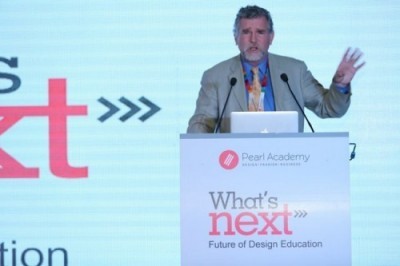At the latest What’s Next event by Pearl Academy, the leading design, fashion and business institute, Darius Sollohub- Director of New Jersey School of Architecture talked about how the millennial generation is taking charge of their own education. The millennial generation is changing every industry that they are touching, it was inevitable for education to be left far behind. They are a generation of collaborative, experiential and result-oriented learners.
He talked about how this might result in online education upturning the institutional learning in the United States with the millennial generation as enrollment dropped by 60% in the past year. Designers, however, have the capability to use this as the studio learning which appeals to the millennial generation is the core of design education. Online courses also, are predicted to take on the course of adaptive learning where students work on modules themselves and collaboratively work towards tangible results in class.
 After a key note by Aditya Dev Sood, Founder and Director of Center for Knowledge Societies, leading thinkers of today’s generation such as- Madhav Raman- Architect and Urbanist, Jogi Panghaal-Design Professional, Rahul Mishra-Fashion Designer, Vikas Satwalekar- Design Academician, Deepankar Bhattacharya- Strategic Design Consultant and many more, discussed the impact of Macro Trends on the way Curriculum will be shaped in the future, how Connecting Organic Knowledge Networks will be essential along with a Responsive Curriculum leading to Shared Tasks across Disciplines for a holistic learning experience for the millennial generation.
After a key note by Aditya Dev Sood, Founder and Director of Center for Knowledge Societies, leading thinkers of today’s generation such as- Madhav Raman- Architect and Urbanist, Jogi Panghaal-Design Professional, Rahul Mishra-Fashion Designer, Vikas Satwalekar- Design Academician, Deepankar Bhattacharya- Strategic Design Consultant and many more, discussed the impact of Macro Trends on the way Curriculum will be shaped in the future, how Connecting Organic Knowledge Networks will be essential along with a Responsive Curriculum leading to Shared Tasks across Disciplines for a holistic learning experience for the millennial generation.
The trends in the education industry will lead students to adapt learning beyond boundaries. Experiential learning will be adapted to more and more with peer to peer learning playing a major role in the curriculum. The future generation of students are most likely to take responsibility of their own curriculum, this change will also lead to a radical change in the student-teacher relationship. The idea of an ‘institution is going through a rapid change and it would be important to define the notions of time in a collaborative learning environment.
Curriculums of the future would need strategies to keep up with sustainable change and there would be a need of elasticity in education. Open-sources where curriculums can be shared can be a way to tackle this. The role of the designer would move to that of a curator in the near future and design education thus should be able to meet the needs of the industry while training the talent. The curriculum of the future would need to enable the collaboration and connection across disciplines. Activities would need to be synchronized in a manner where formal and informal knowledge will be able to adapt to the profile of the students.
Since learning is a life-long process, the curriculum would need to address the various stakeholders in the ‘Age of Collaborations’. Students would look at a playlist sort of curriculum where there is openness, differentiation and a multi-directional learning. Students are leaning towards a curriculum that will provoke the way that they currently think and get them to learn in a manner which gives them more than one area of specialization.
Speaking about the What’s Next initiative, Aditya Dev Sood said, “I think people are ready to re-think pedagogy as a practice and this is a really interesting conference with a set of people who are here with a desire to work through, articulate and defend ideas for the future generation. I am delighted to be a part of this initiative as at Adianta School also, we believe in cross-culture learning. It is encouraging to see that we are working in the right direction.”
Key issues in design education are in constant change and these need to be mapped and monitored into current and ongoing courses for the curriculum to stay relevant and stimulating for both students and faculty. The two day confluence organized by Pearl Academy aimed at a collaborative sharing of insights which will help transform design education going forward.












